
Lincoln State Monument and the Lincoln Folds
Introduction
Lincoln State Monument encompasses most of the community of Lincoln, New Mexico and commemorates the lives of many of the key players in the Lincoln County War (1878-1881). Lincoln, which is located in south-central New Mexico, can be access via U.S. Highway 380 (Figure 1). The community was originally named La Placita del Rio Bonito (village of the pretty river); the stream that runs along the north side of the village is called the Rio Bonito. The legislature of the territory of New Mexico, encouraged by local citizenry, renamed the village Lincoln in 1869, in honor of President Lincoln, who was assassinated 4 years earlier (Julyan, 1998).

The main visitor’s center for the monument is located near the east end of town on the north side of the highway. The Lincoln County Courthouse Museum, which highlights the escapades and legal troubles of William H. Bonney (Billy the Kid), is the other main attraction associated with the monument. The courthouse is on the west end of town on the south side of the highway. Admission tickets ($5 for adults, children under 16 free) may be purchased at the visitor’s center or at the courthouse. Other buildings that can be visited as part of the tour include the Montaño store, the San Juan mission, the torreon (Figure 2), the post office and Turnstall Museum, and Dr. Wood’s home.
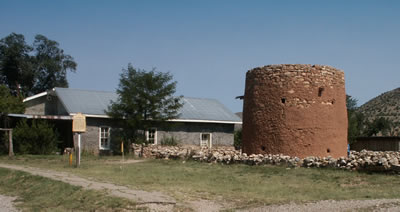
Regional Geologic Setting
Lincoln is on the Pecos Slope, a structural element that dominates southeastern New Mexico (Kelley and Thompson, 1964; Kelley, 1971). Permian sedimentary rocks generally dip gently (approximately 1 degree) to the east and northeast on the Pecos Slope. This feature marks the transition from the extensional Rio Grande rift to the geologically stable Southern High Plains (Figure 3). West of Lincoln, near Capitan, Permian beds dip 5 to 15 ° toward the west into the Sierra Blanca basin (Craddock, 1964), a basin that formed during Laramide compression approximately 38 to 50 million years ago (Figure 4). This basin was later intruded by the Sierra Blanca igneous complex and Lincoln County porphyry belt, which includes the Capitan pluton that is visible on the skyline to the northwest of Lincoln (Figures 3, 4, 5, and 6). This igneous activity occurred between 38 and 26 million years ago (Allen and Foord, 1991).
A segment of the Mescalero Arch, which also formed during Laramide compressional deformation, is located about 5 km west of Lincoln (Figure 5, Kelley and Thompson, 1964; Kelley, 1971; Yuras, 1991). In this area, the arch is a northeast-striking structure that separates the east-dipping Pecos Slope from the west-dipping limb of the Sierra Blanca basin. The Mescalero Arch roughly coincides with the axis of the Pedernal uplift, an ancient mountain range that formed ~280-305 million years ago during Ancestral Rocky Mountain deformation.
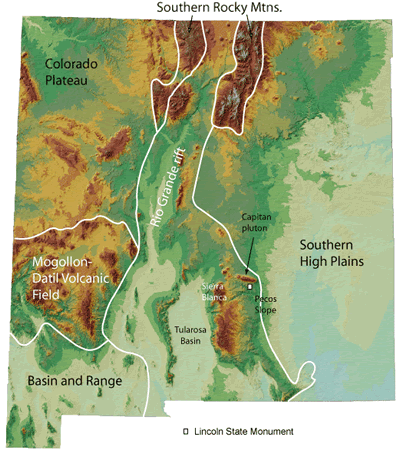
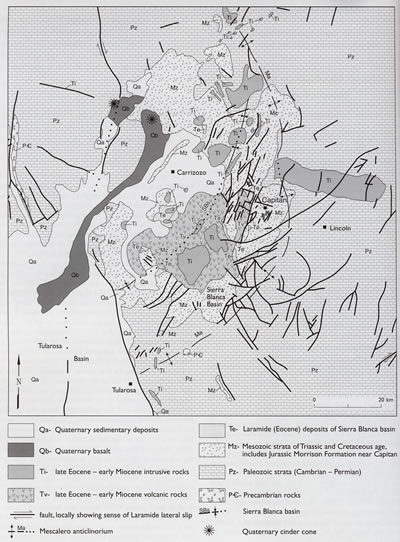
Stratigraphy and Geologic History
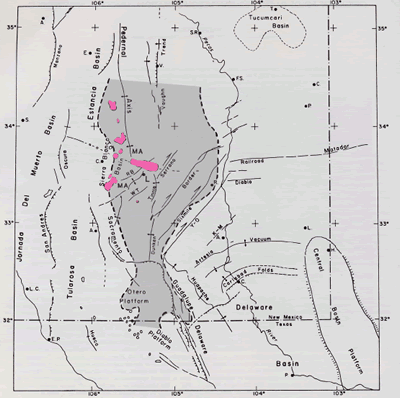
The oldest rock unit exposed in the vicinity of Lincoln is the Permian Yeso Formation (yeso is the Spanish word for gypsum). Although ~365 to 550 meters of siltstone, limestone, shale, mudstone, and gypsum belonging to the Yeso Formation likely underlie the area, only the top 150 m of the unit is exposed along the Rio Bonito (Craddock, 1964, Yuras, 1991). The Yeso Formation is composed of 50 to 65% siltstone and mudstone, 25 to 43 % limestone, and 7 to 10% gypsum in this area (Craddock, 1964; Yuras, 1991). The Yeso Formation was deposited ~276-280 million years ago in an arid, shallow oceanic to tidal environment (Mack and Dinterman, 2002; Kues and Giles, 2004). The waning stages of erosion of the nearby Pedernal uplift may explain the presence of so much siltstone in the Yeso Formation in this particular region (Kelley, 1971; Kues and Giles, 2004).
The Yeso Formation is gradationally overlain by thin (<12 m) beds of Glorieta Sandstone interbedded with fossiliferous limestone of the San Andres Formation. The transitional zone that includes Glorieta Sandstone is ~40 m thick near Lincoln (Craddock, 1964). These units record a rise of sea level in this area approximately ~260 to 276 million years ago.
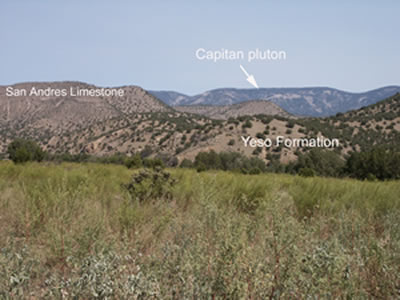
There is a large gap in the geologic record of the Lincoln area after Permian deposition of the San Andres Formation. The next event preserved in the record is the large scale folding of the region during Laramide deformation, as discussed in the preceding section. Smaller scale folding may have formed at the same time (see below). Later, discontinuous mafic to intermediate composition sills were emplaced near the Yeso–San Andres contact in the vicinity of Lincoln. Although these sills have not been dated, they are suspected to be late Eocene to early Oligocene in age and related to the Sierra Blanca igneous complex and Lincoln County porphyry belt (Braddock, 1964; Yuras, 1991). The Capitan pluton, a texturally and chemically zoned granite, was emplaced ~28 million years ago (Figure 6, Allen and McLemore, 1991; Campbell et al., 1994).
Approximately 1 to 1.5 km of erosion has occurred in this area since 26 million years ago, allowing the Capitan pluton to be exhumed (Kelley and Chapin, 1995). The timing of the development of the Rio Bonito is unknown, but valley formation may have been enhanced to some extent by outwash from melting glaciers on Sierra Blanca and melting snowpack on the Capitan Mountains during the last 71,000 to 128,000 years (Foley, 1964; Bragbrough, 1991, 1994).
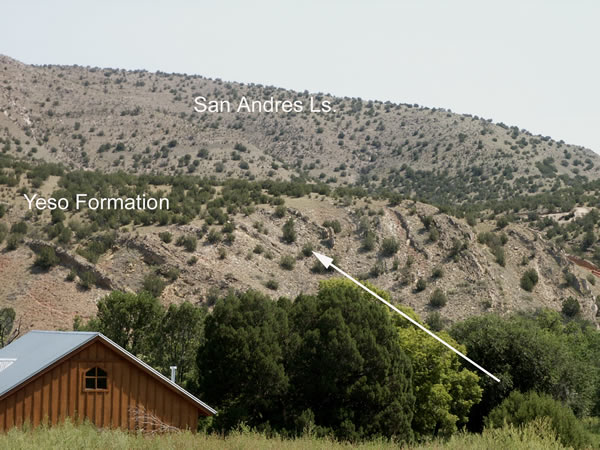
The Lincoln Folds
Introduction
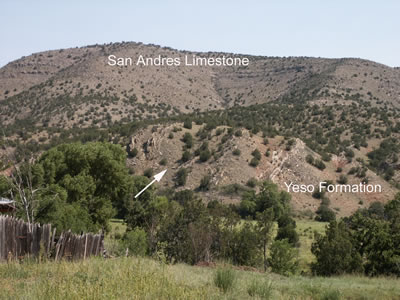
If you look north from the visitor’s center at Lincoln National Monument, you will see that the Yeso Formation on the north side of the Rio Bonito is crumpled like a rug, while the overlying San Andres Formation is relatively undeformed (Figures 7, 8, 9, and 10). How it such a relationship possible? Ideas that have been proposed to explain the folds include soft-sediment deformation during deposition of the Yeso Formation, localized landslide formation, large-scale sliding related to emplacement of intrusions, and Laramide deformation (Semmes, 1920; Talmage, 1935; Panhandle Geological Society, 1939; Craddock, 1964; Foley, 1964; Kelley, 1971, Yuras, 1976, 1991). One of the most intriguing geologic puzzles in the state of New Mexico is the origin of the Lincoln folds.
Description of the Folds
Craddock (1964) and Yuris (1976, 1991) provide excellent descriptions of the folds and their distribution in south-central New Mexico. Yeso Formation containing relatively incompetent siltstone, mudstone, and gypsum underlies much of southern and central New Mexico (Kues and Giles, 2004), but this unit is not strongly deformed across much of this region (Kelley, 1971). The area of strongest deformation within the Yeso Formation lies to the east and the northeast of Sierra Blanca in an area roughly outlined by a triangle drawn between the towns of Corona, Ruidoso, and Arabela (Craddock, 1964; Kelley, 1971). The Tinnie folds, and Border Hills, Six Mile Hill, and Y-O buckles that are 16 to 56 km to the east of Lincoln involve folding of both the Yeso and San Andres formations; thus these structures may or may not be directly related to the Lincoln folds (Foley, 1964; Yuras, 1991).
The limestone beds in the Yeso Formation primarily define the Lincoln folds, while the more incompetent siltstone, mudstone, and gypsum beds deform differently and are variable in thickness (Figure 9). The folds in the limestone commonly trend north and northeast and can be traced about 200 m. The wavelength of the folds is 100 to 370 m and the amplitude is on the order of 120 m. Generally, the folds are regular, upright, concentric, fairly symmetrical, and plunge to the north. Some folds are more box-like, asymmetric, and verge to the west. The folds often die out rapidly upward against the Glorieta/San Andres transitional unit, but in places, the base of the transitional unit is downwarped into the Yeso Formation. Clastic dikes in the San Andres Formation and Glorieta Sandstone that contain material from the Yeso Formation are present at several localities near Lincoln.
Origin of the Lincoln Folds
Many mechanisms have been proposed to explain the folds, but only two hypotheses are considered here.
(1) Craddock (1964) speculated that the folds are the result of large-scale gravitational sliding of the upper Yeso over the lower Yeso Formation, which is in the subsurface beneath the Rio Bonito. He proposes that the sliding occurred mainly during middle Cenozoic (Oligocene?) time because he found older sills fractured by folding north and south of the Lincoln area, but the folds seem to be truncated by the younger Capitan pluton. Tilting caused by inflation of intrusions associated with the Sierra Blanca igneous complex and Lincoln County porphyry belt provided the trigger for sliding.
(2) Yuris (1991) notes that there is no compelling evidence for regional scale eastward tilting due to inflation related to intrusive activity to the west of Lincoln. In fact, the Sierra Blanca igneous complex is made up of only 20% intrusive rocks and lava flows on the south side of the complex dip north, toward the center of the complex rather than away from it (Thompson, 1964; 1972). Yuris (1991) instead proposes that these structures formed during Eocene Laramide compression in association with high fluid pressures in the Yeso Formation, as indicated by the presence of clastic dikes. This mechanism could be consistent with the deformation of sills observed by Craddock (1964) if the sills are Eocene in age.
Craddock (1964) notes evidence for multiple generations of faulting and folding in the vicinity of Lincoln and states “the Yeso may have been mobile over a considerable time span and not merely during the main folding.”

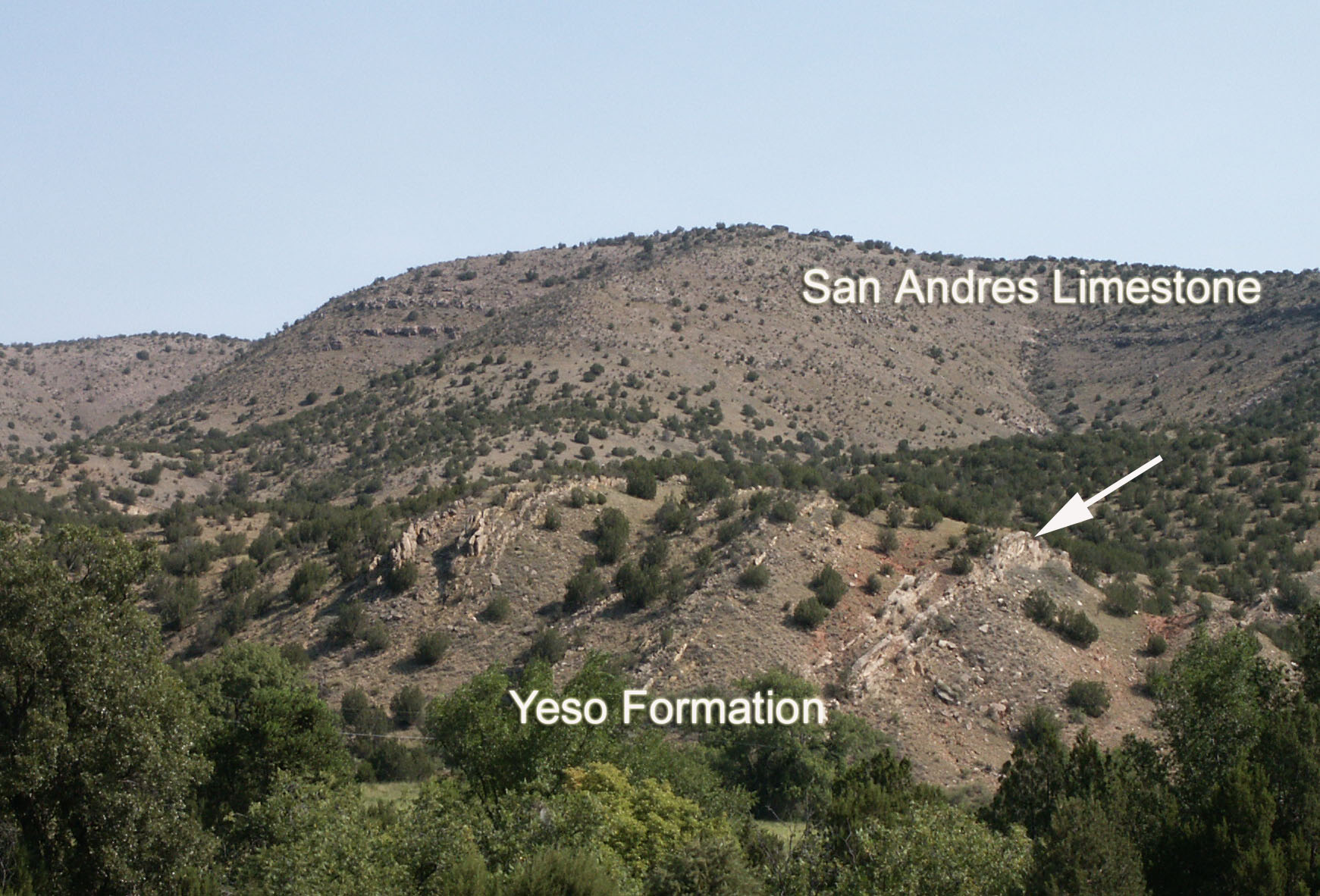
References
- Allen, M.S., and Foord, E.E., 1991, Geological, geochemical and isotopic characteristics of the Lincoln County porphyry belt: implications for regional tectonics and mineral deposits: New Mexico Geological Society Guidebook 42, p. 97-113.
- Allen, M. S., and McLemore, V. T., 1991, The geology and petrogenesis of the Capitan pluton, New Mexico; in Barker, J. M., Kues, B. S, Austin, G. S., and Lucas, S. G. (eds.), Geology of the Sierra Blanca, Sacramento, and Capitan Ranges, New Mexico: New Mexico Geological Society, Socorro, Guidebook 42, pp. 115–127.
- Blagbrough, J. W., 1991, Late Pleistocene rock glaciers in the western part of the Capitan Mountains, Lincoln County, New Mexico: description, age, and climatic significance; New Mexico: New Mexico Geological Society Guidebook 42, pp. 333–338.
- Blagbrough, J. W., 1994, Late Wisconsin climatic inferences from rock glaciers in south-central and west-central New Mexico and east-central Arizona: New Mexico Geology, v. 16, no. 4, pp. 65–71.
- Campbell, A. R., Heizler, M. T., and Dunbar, N. W., 1994, 40Ar/39Ar dating of fluid inclusions in quartz from the Capitan pluton, New Mexico (abs.): Fifth Biennial Pan-American Conference on Research on Fluid Inclusions, Abstracts, p. 11.
- Cather, S.M., 2002, The Sierra Blanca basin: New Mexico Geological Society Guidebook 53, p. 21.
- Craddock, C., 1964, The Lincoln fold system: New Mexico Geological Society Guidebook 15, p. 122-133.
- Foley, E.J., 1964, The Lincoln folds, Lincoln, New Mexico: New Mexico Geological Society Guidebook 15, p. 134-139.
- Kelley, S.A., and C.E. Chapin, 1995, Apatite fission-track thermochronology of Southern Rocky Mountain-Rio Grande rift- western High Plains provinces, New Mexico Geological Society Guidebook 46, 87-96.
- Kelley, V. C., 1971, Geology of the Pecos country, southeastern New Mexico: New Mexico Bureau of Mines and Mineral Resources, Memoir 24, 78 pp.
- Kelley, V.C. and Thompson, T.B., 1964, Tectonics and general geology of the Ruidoso-Carrizozo region, central New Mexico: New Mexico Geological Society Guidebook 15, p. 110-121.
- Kues, B.S., and Giles, K.A., 2004, The Late Paleozoic Ancestral Rocky Mountains system in New Mexico: New Mexico Geological Society Special Publication 11, p. 95-136.
- Julyan, R., 1998, The place names of New Mexico: University of New Mexico Press: Albuquerque, New Mexico, second edition, 385 pp.
- Mack, G.H., and Dinterman, P.A., 2002, Depositional environments and paleogeography of the Lower Permian (Leonardian) Yeso and correlative formations in New Mexico: The Mountain Geologist, v. 39, p. 75-88.
- Panhandle Geological Society, 1939, Guidebook for spring field trip, Sacramento Mountains, White Sands, Sierra Blanca region.
- Semmes, D.R., 1920, Notes on the Tertiary intrusives of the lower Pecos valley, New Mexico: American Journal of Science, v. 50, p. 415-430.
- Talmage, S.B., 1935, Folding of the Chupadera beds near Lincoln, New Mexico: Pan. Am. Geologist, v 64, p. 153-154.
- Thompson, T.B., 1964, A stratigraphic section of the Sierra Blanca volcanics in the Nogal Peak area, Lincoln County, New Mexico: New Mexico Geological Society Guidebook 15, p. 76-78.
- Thompson, T.B., 1972, Sierra Blanca Igneous Complex: Geological Society of America Bulletin, v. 83, p. 2341-2356.
- Yuras, W., 1976, Origin of the Lincoln fold system, Lincoln County, New Mexico [M.S. thesis]: Socorro, New Mexico Institute of Mining and Technology, 97 p.
- Yuras, W., 1991, Origin of folds in the Permian Yeso Formation, Lincoln, New Mexico: New Mexico Geological Society Guidebook 42, p. 165-170.



